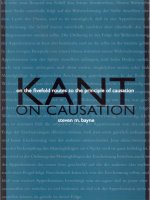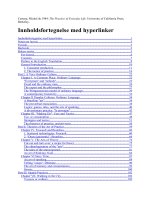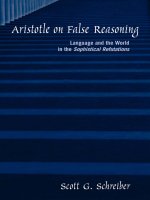university of chicago press foundations of high-energy astrophysics apr 2008
Bạn đang xem bản rút gọn của tài liệu. Xem và tải ngay bản đầy đủ của tài liệu tại đây (2.75 MB, 575 trang )
Foundations of
High-Energy Astrophysics
THEORETICAL ASTROPHYSICS
Fulvio Melia, series editor
EDITORIAL BOARD
A. C. Fabian, Roy Kerr, Douglas N. C. Lin, Angela V. Olinto, Saul Rappaport
Other Theoretical Astrophysics titles available
from the University of Chicago Press
Inner Space / Outer Space
Edward Kolb, Michael Turner, Keith Olive, and David Seckel, editors (1985)
Theory of Neutron Star Magnetospheres
Curtis F. Michel (1990)
High-Energy Radiation from Magnetized Neutron Stars
Peter Meszaros (1992)
Cauldron in the Cosmos
Claus E . Rolf and William S. Rodney (1988)
Stars as Laboratories for Fundamental Physics
Georg G. Raffelt (1996)
Foundations of
High-Energy Astrophysics
Mario Vietri
THE UNIVERSITY OF CHICAGO PRESS
Chicago and London
MARIO VIETRI is professor of astrophysics at the Scuola
Normale Superiore in Pisa, Italy.
The University of Chicago Press, Chicago 60637
The University of Chicago Press, Ltd., London
C
2008 by The University of Chicago
All rights reserved. Published 2008
Printed in the United States of America
17161514131211100908 12345
ISBN-13: 978-0-226-85569-1 (cloth)
ISBN-10: 0-226-85569-4 (cloth)
Library of Congress Cataloging-in-Publication Data
Vietri, Mario.
Foundations of high-energy astrophysics / Mario Vietri.
p. cm.
Includes bibliographical references and index.
ISBN-13: 978-0-226-85569-1 (cloth : alk. paper)
ISBN-10: 0-226-85569-4 (cloth : alk. paper)
1. Astrophysics—Textbooks. 2. Infrared astronomy—Textbooks.
3. X-ray astronomy—Textbooks. 4. Gamma ray
astronomy—Textbooks. 5. Particles (Nuclear physics)—
Textbo oks. I. Title.
QB468.V54 2008
523.01
976—dc22
2007030145
∞
The paper used in this publication meets the minimum
requirements of the American National Standard for
Information Sciences—Permanence of paper for Printed
Library Materials, ANSI Z39.48-1992.
A Luisa, che aveva ragione
Contents
Preface xv
1 Hydrodynamics 1
1.1 The Mass Conservation Equation . . . 2
1.2 The Momentum Conservation Equation . . . 3
1.3 TheEnergyConservationEquation 5
1.4 Bernoulli’s Theorem . . 7
1.5 The Equations of Hydrodynamics in
ConservativeForm 8
1.6 ViscousFluids 11
1.7 SmallPerturbations 15
1.8 Discontinuity 18
1.8.1 SurfacesofDiscontinuity 19
1.8.2 ShockWaves 22
1.8.3 Physical Interpretation of Shock
Waves 23
1.8.4 Collisional and Noncollisional
Shocks 25
1.8.5 FormationofaShock 26
1.9 Self-similarSolutions 28
1.9.1 Self-similar Solutions of the Second
Kind 33
1.10 Relativistic Hydrodynamics . . 38
1.10.1 Shock Waves in Relativistic
Hydrodynamics 41
vii
viii CONTENTS
1.10.2 TheStrongExplosion 43
1.11 The De Laval Nozzle . . 47
1.12Problems 53
2 Magnetohydrodynamics and Magnetic
Fields 55
2.1 EquationsofMotion 56
2.1.1 The Limit of Ideal
Magnetohydrodynamics 60
2.1.2 Equations of Motion in a Conservative
Form 62
2.2 The Force Exerted by the Magnetic Field . . 64
2.3 Magnetic Flux Freezing 66
2.4 Small Perturbations in a Homogeneous
Medium 70
2.5 Stability of Tangential Discontinuities 77
2.6 Two-TemperatureFluids 81
2.7 Magnetic Buoyancy and Reconnection 84
2.7.1 Magnetic Buoyancy . . 84
2.7.2 Reconnection 88
2.8 ShockWaves 92
2.9 Magnetic Fields in Astrophysics 95
2.9.1 Observations 95
2.9.2 Origin of Magnetic Fields . . . 101
2.10Problems 113
3 Radiative Processes 115
3.1 RadiativeTransport 115
3.1.1 RadiationTransport 120
3.2 Low-TemperatureThermalEmission 124
3.3 Bremsstrahlung . 128
3.4 Synchrotron 131
3.4.1 Power Radiated by a Single Particle . 131
3.4.2 The Spectrum of a Single Particle . . 134
CONTENTS ix
3.4.3 The Spectrum of a Group of
Nonthermal Particles . . 138
3.4.4 Quantum Corrections . 140
3.4.5 Self-absorption 142
3.4.6 Cyclotron Lines . 144
3.4.7 Processes in an Intense Magnetic
Field . . . 146
3.4.8 TheRazin-TsytovichEffect 148
3.5 ComptonProcesses 150
3.5.1 Physical Mechanism of the Inverse
Compton 152
3.5.2 The Spectrum of Inverse Compton
Processes 157
3.5.3 AbouttheComptonParameter 167
3.5.4 Self-synchro-Compton and Compton
Limit 168
3.5.5 ComptonBroadening 171
3.6 Relativistic Effects . . . 172
3.6.1 Superluminal Motions . 173
3.6.2 Emission Properties of Relativistic
Sources . 174
3.7 PairCreationandAnnihilation 177
3.8 Cosmological Attenuations . . . 181
3.8.1 Protons 181
3.8.2 Photons 186
3.9 Problems 188
4 Nonthermal Particles 191
4.1 The Classic Theory of Acceleration . . 192
4.1.1 Acceleration . . . 193
4.1.2 Injection 206
4.2 Constraints on the Maximum
Energy 208
x CONTENTS
4.3 More Details in the Newtonian
Limit 213
4.3.1 From the Vlasov Equation to the
Convection-Scattering Equation 215
4.3.2 Scattering in the Angle of Motion in a
MediumatRest 217
4.3.3 Scattering and Convection in a
MediuminMotion 219
4.4 GeneralDiscussion 226
4.4.1 An Equation for f 227
4.4.2 The Small Pitch Angle Scattering
Limit 232
4.4.3 Distributions of Probability P
u
and P
d
238
4.4.4 The Particles’ Spectrum 241
4.4.5 The Equations for P
u
and P
d
243
4.4.6 Results 247
4.5 The Unipolar Inductor . 250
4.6 Problems 254
5 Spherical Flows: Accretion and Explosion 255
5.1 Accretion from Cold Matter . . 256
5.2 Accretion from Hot Matter . . 260
5.2.1 TheCriticalPoint 265
5.3 TheIntermediateCase 267
5.4 Doubts about the Bondi Accretion Rate . . . 268
5.5 TheEddingtonLuminosity 270
5.6 The Efficiency of Spherical Accretion . 275
5.7 ExplosiveMotions 277
5.7.1 Supernovae 278
5.7.2 Gamma Ray Bursts . . 286
5.8 Problems 300
6 Disk Accretion I 303
6.1 QualitativeIntroduction 305
6.2 FundamentalEquations 307
CONTENTS xi
6.3 Special Relations 310
6.4 The α Prescription 315
6.5 EquationsfortheStructureofDisks 318
6.6 TheStandardSolution 322
6.7 The Origin of Torque . . 326
6.8 Disk Stability . . 331
6.8.1 TimeScales 331
6.8.2 Instability 332
6.9 Lense-Thirring Precession . . . 337
6.10Problems 345
7 Disk Accretion II 347
7.1 OtherDiskModels 347
7.1.1 The Origin of Particles . 349
7.1.2 Dynamic Peculiarities of Pair
Plasmas . 351
7.1.3 The Pair Plasma without Input of
ExternalPhotons 352
7.1.4 The Pair Plasma with Input of
ExternalPhotons 362
7.2 Thick Accretion Disks . 366
7.2.1 SomeGeneralProperties 368
7.2.2 The Inapplicability of the
EddingtonLimit 371
7.2.3 PolytropicModels 374
7.2.4 PropertiesofThickDisks 376
7.3 Nondissipative Accretion Flows 379
7.4 FurtherDevelopmentsoftheTheory 386
7.4.1 General-Relativistic Corrections . . . 387
7.4.2 The Fate of Angular Momentum at
LargeRadii 387
7.5 Accretion Disks on Magnetized
Objects 393
7.5.1 The Alfv´enRadius 394
xii CONTENTS
7.5.2 Interaction between the Disk and
the Magnetosphere . . . 401
7.5.3 Accretion Columns . . . 403
7.6 Boundary Layers 414
7.7 Problems 417
8 Electrodynamics of Compact Objects 419
8.1 TheGold-PaciniMechanism 420
8.2 The Magnetospheres Surrounding Pulsars . . 422
8.2.1 Quasi-Neutral or Charge-Separated
Plasma? . 427
8.2.2 The Goldreich and Julian
Magnetosphere . 429
8.2.3 ThePulsarEquation 432
8.2.4 TheSolution 443
8.2.5 The Transport of Angular Momentum 444
8.2.6 Discussion 448
8.3 The Blandford-Znajek Model . 450
8.3.1 The Magnetic Field of a Black Hole . 450
8.3.2 TheBlackHoleEquation 456
8.3.3 The Transport of Energy and of
Angular Momentum . . 470
8.3.4 AQualitativeDiscussion 473
8.3.5 A Simplified Discussion of Total
Energetics 475
8.4 TheGenerationofCharges 479
8.5 Disk-JetCoupling 482
8.5.1 The Lovelace-Blandford Model 484
8.5.2 A Special Solution . . . 485
8.5.3 Discussion 490
8.5.4 A Model Including Inertial Effects . . 494
8.5.5 A Special Solution . . . 500
8.5.6 Results 503
8.5.7 A Brief Summary 508
8.6 Problems 510
CONTENTS xiii
Appendix
A Propagation of Electromagnetic Waves 513
B Orbits Around Black Holes 519
B.1 Problem 527
C Useful Formulae 529
C.1 VectorIdentities 529
C.2 Cylindrical Coordinates 529
C.3 Spherical Coordinates . 530
Bibliography 533
Index 543
Preface
When we bring a new scientific text to the attention of col-
leagues and students, it is necessary to provide a justification
for this novelty. The main reason that drove me to write this
book is the desire to present all the basic notions useful to the
study of the current scientific literature in one single volume.
The choice of topics included in this book has been mo-
tivated primarily by this statement. Chapters 1 through 3
present those basic notions (hydrodynamics, magnetohydro-
dynamics, and radiative processes) that are indispensable
for successive developments. Chapters 4 through 7 treat the
classical topics of high-energy astrophysics: the acceleration
of nonthermal particles, astrophysical accretion flows, both
spherical and disk-shaped, and explosive motions (supernovae
and gamma-ray bursts). Chapter 8 presents the basic results
of electrodynamics around compact objects.
The second half of chapter 2, as well as the whole of chap-
ters 7 and 8, present material not usually included in text-
books on high-energy astrophysics. The second half of chap-
ter 2 contains a discussion of magnetic fields in astrophysics:
methods of measurement and their results, and the funda-
mental ideas of batteries (generating the seeds of astrophys-
ical magnetic fields) as well as of dynamos (amplifying these
seeds). These topics are hardly ever found in high-energy as-
trophysics textbooks, even though they are crucial for an un-
derstanding of various phenomena, such as the acceleration of
non-thermal particles, accretion disks on magnetized objects,
and pulsars. The discussion is kept at a basic level and must
xv
xvi PREFACE
be considered a simplified introduction to a very complex sub-
ject. Chapter 7 contains further developments in the theory of
accretion disks which have acquired a certain relevance only
in the last few years, namely, pair plasmas in the hot coronae
of accretion disks, accretion flows dominated by advection,
thick disks, and accretion on strongly magnetized objects. In
chapter 8 I discuss those processes in which the coupling be-
tween magnetic field and rotation plays a fundamental role:
here I introduce the main results on the magnetospheres of
pulsars and black holes, as well as the coupling between disk
and magnetic field, with the ensuing collimation of jets.
The choice of topics omitted from this book also requires
an explanation. I decided to neglect all phenomena connected
with the interiors of neutron stars and white dwarfs. Apart
from the fact that these topics are outside my expertise,
this choice is due to the presence of the beautiful book by
Shapiro and Teukolsky, Black Holes, White Dwarfs, and Neu-
tron Stars (1983), which, though a bit old, still provides a
wonderful introduction to the subject. Furthermore, there is
no discussion of the observational properties of astrophysi-
cal objects, nor of the match (or mismatch!) between theory
and observations. This neglect is certainly more unusual and
requires an explanation. At first, I wanted to include these
topics as well and present a more complete textbook. How-
ever, the increased dimensions of this volume, as I added
chapter after chapter, convinced me that it was impossible to
illustrate, in a satisfactory way, both observations and their
comparison with theory, within the reasonable boundaries of
a textbook. Moreover, while there are many complete and
timely review articles about observational data, it is more
difficult to find a systematic introduction to theoretical top-
ics. That is why I chose, even if with many regrets, to leave
out these other subjects. The only comfort I can find is that,
inevitably, the observations (thanks to continuous technolog-
ical innovations, the construction of new telescopes, and the
launch of new space missions) are destined to become obso-
lete more quickly than theory.
PREFACE xvii
The contents of this book are obviously excessive for any
university course, but one can pick out the material to be cov-
ered by taking into account what follows. Chapters 1 through
6 are written so that the initial parts cover the fundamen-
tal notions, while further developments of lesser generality
and/or interest are discussed in the last few paragraphs of
each chapter. On the other hand, chapter 6 is fundamental,
and only the paragraphs about the analysis of the stability
of disks and the Lense-Thirring effect can be considered op-
tional. Chapters 7 and 8 are certainly complementary and can
be treated according to the interests of lecturer and students.
The problems at the end of each chapter are generally
easy. The exceptions to this rule contain a reference to where
the solution is accurately derived. The exception to the ex-
ception is the exercise in appendix 2 (problem 1), which is
rather difficult; since it has never been proposed as an ex-
ercise, I cannot suggest a reference for the solution, which,
however, will certainly not be missed by the experts on the
gravitomagnetic field. Problem 2 in chapter 5 may appear
deprived of the information necessary for the solution, but
this is not so: it actually proposes the real-life situation of
astronomers, who sometimes manage to find ingenious solu-
tions to (apparently) unsolvable problems.
Pasquale Blasi (who also wrote section 4.3 of this book),
Giorgio Matt, and Luigi Stella gave me support and sugges-
tions during the preparation of this work, and Lorenzo Sironi
carried out and corrected most exercises; I would like to thank
them from my heart. Of course, any errors are my exclusive
responsibility. I would never have thought of writing a book
without the help of my father Dario and of my wife Luisa.
This book is dedicated to them, as well as to those friends
(Renato Finocchi, Vincenzo Guidetti, and Antonio Navarra)
who, even though they will never read it, have contributed
so much to its realization.
Chapter 1
Hydrodynamics
Most astrophysical phenomena involve the release of energy
either inside or outside of stars, within the interstellar me-
dium. In both cases, the medium where the energy emission
takes place is a fluid, which, because of this energy release,
starts moving, expanding or contracting, becoming warmer
or colder. The properties of the radiation emitted (photons,
neutrinos, or nonthermal particles), measured by us on Earth,
depend—in detail—on the thermodynamic state and on the
speed of the fluid where the emission takes place. Therefore,
we can say that a necessary prerequisite for high-energy as-
trophysics is the study of hydrodynamics and magnetohydro-
dynamics.
In this chapter, I shall briefly explain the fundamental
principles of hydrodynamics, as well as some key results,
which will often be used in the following chapters. In partic-
ular, I shall first discuss the fundamental equations of hydro-
dynamics, and their rewording as conservation laws for the
energy-momentum tensor. I shall derive Bernoulli’s theorem,
the properties of small perturbations (or sound waves), tan-
gential discontinuities, and, last but not least, shock waves.
Second, I shall discuss the properties of self-similar solutions
of the first and the second kind. Finally, I shall discuss the
1
2 CHAPTER 1. HYDRODYNAMICS
general principles of relativistic hydrodynamics and shock
waves, and de Laval’s nozzle.
1
Hydrodynamics considers a fluid as a macroscopic object,
therefore, ideally, as a continuous medium. Even when we
consider infinitesimal volumes of fluids, elements, or particles
of fluid, we will always assume them to be made up of a very
large number of molecules.
The description of a fluid in a state of rest requires knowl-
edge of its local thermodynamical properties. We shall assume
here knowledge of its equation of state, so that it is necessary
to provide only two of the three fundamental thermodynam-
ical quantities (namely, pressure, density, and temperature).
A generic fluid not in a state of rest will be therefore described
also by the instantaneous speed of motion. In the following,
we shall suppose that all these quantities (P, ρ,T,v) are con-
tinuous functions of space and time, in accordance with the
above.
1.1 The Mass Conservation Equation
The first fundamental law of fluids expresses mass conserva-
tion. Let us consider a volume V containing a fluid mass ρV .
The law of mass conservation states that mass can neither be
created nor destroyed, so that the mass inside V can change
only when a certain amount crosses the surface of the volume
in question. The quantity of mass crossing an infinitesimal el-
ement d
A of area, per unit time, is ρv · d
A. Let us take, as
a convention, the outward area element d
A; in this way, a
positive mass flow ρv ·d
A corresponds to an amount of mass
leaving the volume V . The total mass flow through the sur-
face will therefore be
ρv · d
A (1.1)
1
These sections can be left out in a first reading.
1.2. THE MOMENTUM CONSERVATION EQUATION 3
corresponding to the total mass lost by the volume V ,per
time unit:
−
d
dt
ρdV (1.2)
By comparison, we find that
−
d
dt
ρdV =
ρv · d
A (1.3)
which is the expression of mass conservation in integral form;
please notice that this law applies to any quantity that can be
neither created nor destroyed, such as, for instance, electric
charge, as well as baryonic or leptonic numbers. However, it
is convenient to write the above equation in differential form:
since the volume V does not change as time passes, we have
−
d
dt
ρdV = −
∂ρ
∂t
dV (1.4)
while the right-hand side can be rewritten by means of
Gauss’s theorem:
ρv · d
A =
∇·(ρv) dV (1.5)
Thus we find
∂ρ
∂t
+ ∇·(ρv) = 0 (1.6)
which is the equation we were looking for. This equation ex-
presses, in differential form, the fact that mass can be neither
created nor destroyed: mass changes within a volume only if
some is added or taken away by a mass flow (ρv) crossing the
surface of the given volume.
1.2 The Momentum Conservation
Equation
It is well known that a fluid exerts a force pd
A on an area
element d
A, where p is the pressure. Therefore there is a
4 CHAPTER 1. HYDRODYNAMICS
pressure −
pd
A on a fluid within a volume dV .Thiscan
be rewritten as
−
pd
A = −
pdV (1.7)
which, in its turn, can be interpreted as follows: on each
element of mass ρdV contained in an element of volume dV
a pressure is exerted that equals −∇pdV . The equation of
motion of this infinitesimal mass is thus
ρ
Dv
Dt
= −∇p (1.8)
Here the derivative Dv/Dt represents the acceleration of a
fixed element of mass and is therefore different from ∂v/∂t,
which is the variation of speed at a fixed point. In order to see
the connection between the two, let us consider an element of
mass placed at x
0
at the time t
0
; this moves with speed v
0
=
v(x
0
,t
0
). A time dt later, the same element is in a new posi-
tion, ≈ x
0
+ v
0
dt, where it moves with speed v
1
≈ v(x
0
+
v
0
dt, t
0
+ dt). Its acceleration is therefore
Dv
Dt
= lim
dt→0
v
1
−v
0
dt
=
∂v
∂t
+(v ·∇)v (1.9)
which eventually allows us to write the equation of fluid
motion as
∂v
∂t
+ v ·
∇v = −
1
ρ
∇p +
1
ρ
f
ext
(1.10)
This is exactly the equation we were looking for, which is
called Euler’s equation, or the equation of momentum con-
servation, even though, in its current formulation, it does not
appear formally similar to equation 1.6; we shall illustrate
later on (sect. 1.5) how it is possible to rewrite it so that its
nature as an equation of conservation is clearer.
The term
f
ext
includes all forces of a nonhydrodynamic
nature, for example, within a gravitational field,
f
ext
= −ρ∇φ (1.11)
1.3. THE ENERGY CONSERVATION EQUATION 5
where φ is the gravitational potential. Friction forces are also
included in
f
ext
; these forces are not always negligible in as-
trophysics; that is why we shall soon discuss viscous fluids. In
the meantime, let us simply assume that all fluids are ideal.
The operator
DX/Dt ≡ ∂X/∂t + v ·
∇X (1.12)
expresses the time variation of any physical quantity X,when
we consider its variation not at a fixed position, but for a
fixed element of mass. In other words, if we concentrate on a
certain element of mass and follow it in its motion, DX/Dt
expresses the variation of X with time, just as we would see
it if we straddled the element of mass in question. Because
of this, the operator D/Dt is called the convective derivative,
from the Latin convehere, which means “to carry.”
1.3 The Energy Conservation Equation
We have already assumed that our fluid is ideal and there-
fore not subject to dissipative phenomena, which are often
so important for laboratory fluids. In particular, we have
neglected friction and thermal conduction. Supposing that
there are no further dissipative mechanisms, the equation
of energy conservation must simply establish that the en-
tropy of a given element of mass does not change as time
varies. Therefore, as far as the specific entropy s is concerned,
namely, entropy measured per unit mass—not unit volume,
its convective derivative (namely, for a fixed element of mass),
vanishes:
Ds
Dt
=
∂s
∂t
+ v ·∇s = 0 (1.13)
In astrophysics, the fundamental dissipation process is ra-
diation, since fluids are so rarefied that the chances that a
photon, once emitted, is rapidly reabsorbed, are often (but
not always!) negligible. In this case, the specific entropy can-
not be conserved, and the above equation must be modified,
6 CHAPTER 1. HYDRODYNAMICS
as we shall explain in a minute. However, even in radiative
cases, this equation is valid to a certain extent. This is due to
the fact that radiative processes take place on definite time
scales (which will be discussed in chapter 3), and therefore all
phenomena taking place on shorter time scales are essentially
adiabatic, namely, without heat loss.
Assuming the fluid to be ideal, and that therefore equa-
tion 1.13 holds, we can rewrite it in a more suggestive form,
using equation 1.6. It is actually easy to see that
∂(ρs)
∂t
+ ∇·(ρsv) = 0 (1.14)
which has the same form of the equation 1.6. ρs is the en-
tropy density per unit volume, and ρsv is the entropy flux.
We can see that this equation can be easily interpreted as fol-
lows: in an ideal fluid (namely, an adiabatic fluid) the entropy
within a given volume can be neither created nor destroyed
but changes only because of a flux through the surfaces of
the given volume, which is the same as the interpretation of
the equation of mass conservation.
The most common reason in astrophysics for changes of
entropy is that the fluid is heated and cooled by a certain
number of radiative processes. We define with Γ and Λ the
heating and cooling coefficients per unit mass and time; the
equation of energy conservation can therefore be rewritten as
Ds
Dt
=Γ−Λ (1.15)
or, alternatively,
∂(ρs)
∂t
+ ∇·(ρsv)=ρΓ − ρΛ (1.16)
The coefficients ρΓandρΛ are, respectively, heating and cool-
ing coefficients per unit volume and time. Please note that in
the literature there is often some confusion: the terms Γ and
Λ can indicate either terms per unit mass or per unit volume.
Assuming the fluid to be adiabatic, we can rewrite Euler’s
equation 1.10 in a useful form. If is the internal energy of









